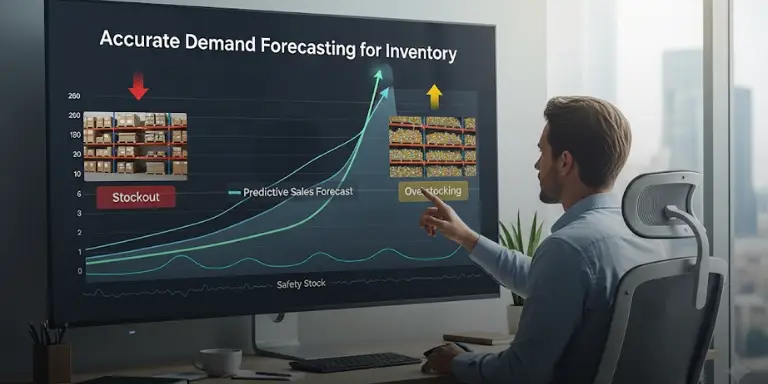
Running an online store is exciting—but it also comes with challenges. One of the biggest struggles for many businesses is managing inventory effectively. According to recent studies, businesses lose over $1.1 trillion every year worldwide due to poor inventory management. That’s a huge number, and it highlights the critical importance of inventory control to success. Think about it. If you don’t have enough stock, customers get frustrated and leave. If you carry too much stock, your cash is tied up in items sitting on shelves, collecting dust, and even losing value. That’s where inventory cost reduction strategies come in. These strategies are about more than just saving money—they help you run a smoother, more profitable business while keeping customers happy.
In this article, we’ll explore practical inventory management best practices, real-life examples, and inventory optimization techniques that online store owners can use to reduce costs, improve efficiency, and grow their businesses.
Before diving into the tips, let’s understand why inventory is such a big deal. For e-commerce stores, inventory is often the largest investment. Every dollar spent on stock is a dollar not available for marketing, operations, or growth. Poor planning can lead to:
Good inventory management isn’t just about knowing what’s in your warehouse—it’s about making smart decisions that directly affect your bottom line. Let’s now look at the best ways to cut inventory expenses while still meeting customer demand.

Accurate forecasting is the foundation of all inventory cost reduction strategies. If you can predict customer demand, you’ll know exactly how much to order and when. This avoids both stockouts and overstocking.
Forecasting won’t be perfect every time, but by combining data, tools, and market awareness, you’ll get closer to the sweet spot.

Imagine running a store but not knowing how much stock you actually have. That’s the reality for many businesses relying on outdated systems. A reliable tracking system is one of the best inventory management solutions for businesses of all sizes.
Good tracking prevents surprises. You’ll know when to reorder, which products move fastest, and where you’re losing money.

Balancing how much stock you carry is one of the best ways to cut inventory expenses. Carry too much, and you’re paying for storage and risking markdowns. Carry too little, and you’re losing sales.
Technology has transformed the way businesses handle inventory. Relying only on manual methods is risky—it’s slow, error-prone, and costly. By adopting modern tools, you can apply inventory management best practices more effectively.
Technology may require upfront investment, but the long-term savings and efficiency gains are significant.

At the end of the day, inventory isn’t just about numbers—it’s about customer experience. Even the most advanced inventory optimization techniques fail if customers can’t get what they want, when they want it.
Customer trust is fragile. Get inventory wrong, and you lose more than sales—you lose loyalty.
Here’s a quick look at how different companies managed their inventory—and what you can learn from them:
| Company | Outcome | Lesson Learned |
| Amazon | Success | Real-time tracking and automation reduce delays and lower inventory costs. |
| Zara | Success | Daily demand analysis helps them match supply with customer demand quickly. |
| Toys “R” Us | Failure | Outdated systems led to stockouts during holidays → unhappy customers. |
| Forever 21 | Failure | Overstocking trendy items forced heavy markdowns and losses. |
| Walmart | Success | AI-powered systems streamline inventory across thousands of locations. |
Smart inventory management isn’t optional—it’s the lifeline of a profitable online store. By applying inventory cost reduction strategies like accurate forecasting, real-time tracking, optimized stock levels, and technology integration, you can slash expenses while improving customer satisfaction.
Think of it this way: companies like Amazon and Zara succeed not just because of marketing but because they’ve mastered the art of inventory management. On the other hand, stories like Toys “R” Us and Forever 21 remind us of what happens when businesses ignore these best practices.
Now it’s your turn. Start small, pick one or two strategies, and apply them consistently. Over time, you’ll discover the best ways to cut inventory expenses, improve cash flow, and delight customers.
Businesses can reduce inventory costs by improving demand forecasting, negotiating better supplier terms, and adopting inventory optimization techniques. Regular audits, cycle counting, and eliminating obsolete stock also help. Technology like inventory management software provides real-time visibility, helping businesses balance stock levels and avoid excess holding costs.
The best ways to cut inventory expenses include applying ABC analysis, implementing just-in-time inventory, and using automation tools. Partnering with reliable suppliers, reducing storage costs, and streamlining logistics can further minimize expenses. Regularly reviewing safety stock levels ensures that companies don’t tie up capital in unnecessary inventory.
The most effective inventory reduction methods are demand forecasting, just-in-time systems, vendor-managed inventory, and lean management practices. These methods reduce excess stock, improve cash flow, and optimize warehouse space. Additionally, tracking fast- and slow-moving products helps businesses prioritize replenishment strategies and avoid costly overstocks.
ABC analysis categorizes inventory into three groups: A (high-value, low-quantity), B (moderate-value), and C (low-value, high-quantity). This helps businesses focus resources on managing their most valuable items while reducing costs on lower-priority products. By applying ABC analysis, businesses can optimize stock levels, improve forecasting, and cut carrying expenses.
Just-in-time (JIT) inventory reduces costs by minimizing excess stock and storage expenses. Instead of keeping large quantities in warehouses, businesses order products only when needed. This strategy lowers holding costs, reduces waste from obsolete items, and improves cash flow. However, it requires strong supplier relationships to avoid delays.
Examples of cost-saving inventory strategies include using demand forecasting software, applying ABC analysis, implementing just-in-time systems, and outsourcing storage. Other methods involve negotiating bulk discounts, automating reorders, and reducing obsolete stock. Each strategy helps businesses strike a balance between customer demand and operational efficiency.
To forecast demand, businesses use historical sales data, seasonal trends, and predictive analytics. Advanced inventory management solutions integrate real-time data from multiple sales channels, improving accuracy. Accurate forecasting helps avoid stockouts, reduce excess inventory, and optimize cash flow. Businesses can also apply AI-driven tools to refine predictions.
